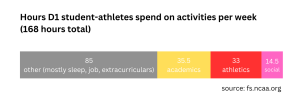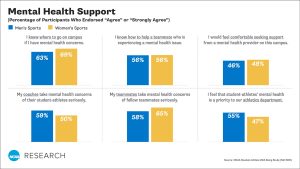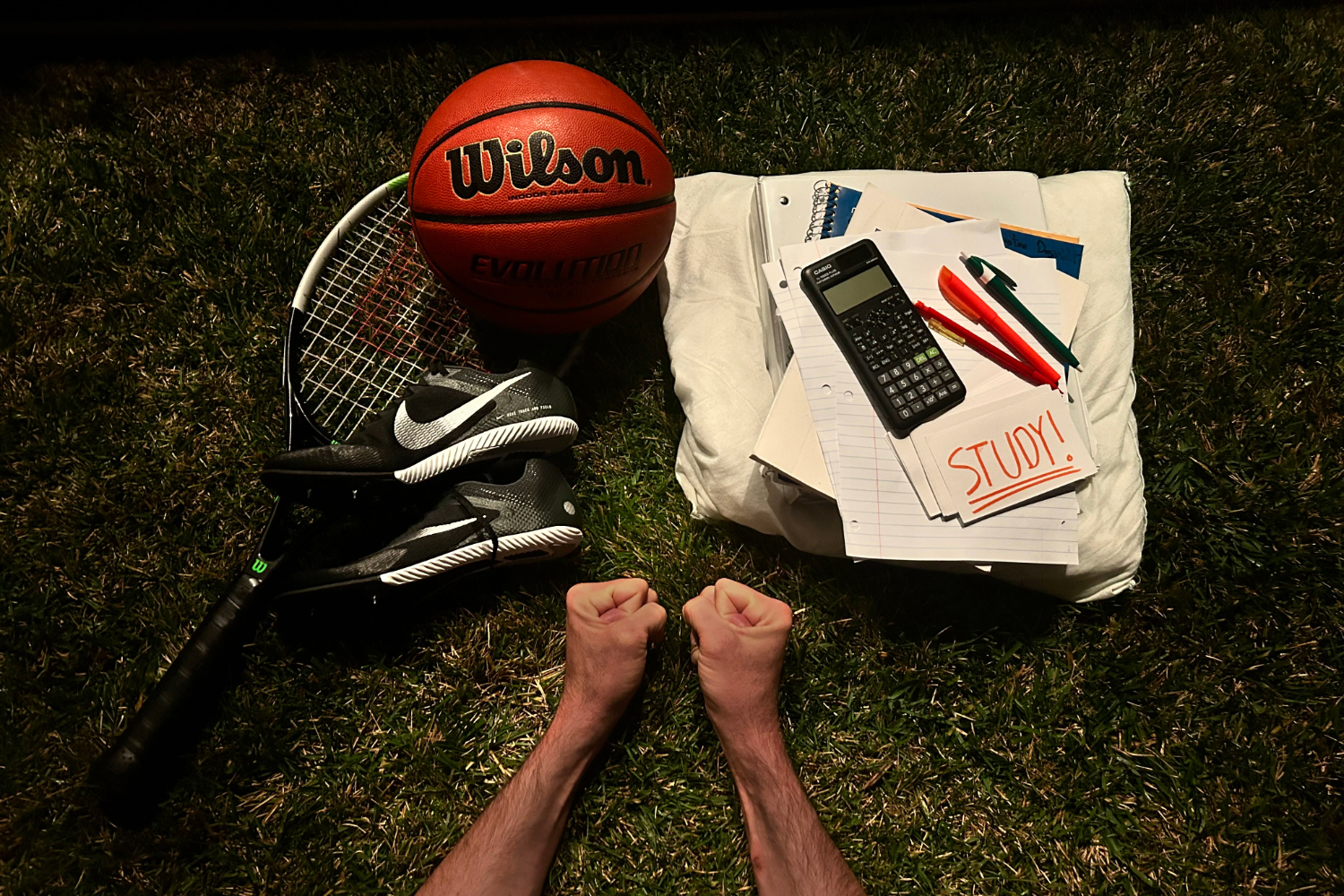Wake up at 7:00, go to the morning team run at 7:45, quickly shower, eat, get some last-minute work in, get ready for class at 12:00 to 2:00, get more work in, eat lunch before visiting the athletic trainer at 3:00, another practice at 4:00, team dinner at 6:00, prepare and pack for a meet tomorrow, study a bit more before going to sleep at 10:00.
This is what a typical day for Division 1 (D1) student-athlete, Myles Collins, looks like, who is a senior at Georgia Tech and a cross country and track runner.
Student-athletes have a lot to manage, especially in D1 schools. Not only are they playing at the highest collegiate level, but they are also enrolled in regular college courses just like any other student.
“I just don’t think anything compares to a D1 sport in college, the level of demand is so much higher,” said senior Yale football player Joseph Vaughn.
.
Athletic Life
First and foremost, an obvious factor that impacts a lot of their lives is the time student-athletes spend on their sport, such as practice, lifting, and games.
Most Division 1 athletes practice six or seven days a week. On top of that, they have about two to three activities connected to their sport each day. This could include morning/afternoon practices, lifting, visits to the athletic trainer, team meetings, team meals, and much more.
“It really depends on the day, but if you average it out, I’d say we practice about 2 to 2 ½ hours a day,” Collins said.
To prevent excessive training, the National Collegiate Athletic Association (NCAA) added a couple of rules. During the playing season, student-athletes are limited to a maximum of four hours of athletically related activities per day and 20 total hours per week. During the off-season, athletically related activities are limited to a maximum of eight hours per week, of which not more than two hours per week may be spent on individual skill workouts.
According to junior Grand Canyon University (GCU) softball player Ashley Trierweiler, her coaches, like most coaches, do a pretty good job of following these limits. However, they still use practically all of the allowed hours. Senior Purdue swimmer Charles King and Vaughn reported that they practiced about 20 hours a week.
However, this rule fails to mention that the NCAA’s “athletically related activities” exclude injury treatment/prevention, visits to the athletic trainer, recovery, travel, etc. According to research by the NCAA in August 2023, with all the extra components, the average D1 student actually spends 33 hours on athletics per week.
“With the total football hours, I’d say we probably spend about 50 hours,” Vaughn said.
Keeping up with all of these activities can easily get tough physically and mentally. A great deal of passion for their sport is required to keep up with this packed sports schedule.
“I’ve had times where I don’t feel like getting in the water, but I just focus on that farther goal in the future. It always keeps me motivated to keep going,” King said.
.
.School Life
“Be a student-athlete, not an athlete-student.” This phrase is commonly heard in the student-athlete world, meaning that you need to be a student first, and then an athlete. This is essential to remember because although athletes, especially at a D1 level, focus a lot of their lives on their sport, they still need to keep their grades up.
The primary reason student-athletes are at college isn’t for their sport, but for their education. Just like any other student, they are expected to complete their credit hours, complete all the associated work, and most importantly, keep good grades.
“You have to be excellent in both school and your sport,” Trierweiler said.
Just like any other student, student-athletes have classes most weekdays. Each day, they can have one to three classes, homework, and studying to do. Stacking all of that on top of an already-packed sports schedule seems nearly impossible.
“You’re still expected to complete a full course at the university. Especially here at a top university, it’s pretty hard,” Vaughn said.
According to a study of 409 Pacific Coast Conference (Pac-12) student-athletes from nine different universities, 54% of athletes say they do not have enough time to study for tests.
.
On top of that, student-athletes miss a lot of class due to traveling. In season, student-athletes can travel close to every week, causing them to miss a lot of classes. It is the student’s responsibility to complete all their work while gone, usually taking advantage of plane and airport waiting time to catch up on school.
For them, it is work, competition, and back to work, with little to no break.
“You’ll be on road trips for more than half the week, and you’re missing class, and you’re missing all of this material. And you have to figure out how to make it up and how to still be that student,” Trierweiler said.
These athletes’ drive and dedication to the things they love help guide them through their tough schedules.
“I know this lifestyle isn’t for everybody, you really have to be extremely passionate. But for me personally, it’s what I love to do, so it’s all worth it,” Vaugh said.
Balancing it out
.The transition between being high school to college athletes is a huge challenge for most student-athletes.
All of the athletes interviewed had a hard time at the beginning of their college experience.
“It definitely took a lot of time to adjust, especially freshman year was very challenging. There was a lot of trial and error,” Vaughn said.
Although they’ve been balancing intense sports and school pretty much their whole life, this was their first experience doing it independently. They no longer had anyone focused on them and how they managed their day.
“I know people who struggled with schoolwork for their first year of college because you’re not at home anymore. You don’t have your mom or your dad looking over your shoulder to make sure you are completing everything,” Trierweiler said.
With them being independent comes managing their own time. With the increase of level in their education and sport, every collegiate athlete needs excellent time-management skills. Nearly all interviewed athletes explained how balancing everything out was a big challenge for them.
“All I’ve done is school, swim, lift, study. I just want to sleep,” King said.
Their intense schedule often irritated them, especially because they couldn’t find a lot of free time. But with time, they slowly learned how to handle their time more efficiently and gained free time every day. 
A few patterns stuck out in how these student-athletes organize their time. Firstly, planning out their busy schedule is crucial. Not just big events such as exams, practices, and games. They write down pretty much every little thing they are going to do, like when they’re going to eat, sleep, socialize, study, etc.
“My biggest piece of advice would be to get a journal. Write everything down. I get a journal every year. Write down your due dates, write down your goals. That helps me to strive for something,” Collins said.
Another thing that was frequently mentioned was to cut down on all unnecessary things, such as scrolling through Instagram or TikTok. They don’t have much time to waste.
For any advice or help, upperclassmen teammates are always there. They have likely been through the exact same thing in the past and will always be there for each other, especially since teammates see each other on a daily basis. Some athletes also use religion and faith to guide them when they are in need of help.
Once these athletes learned to organize their days, they actually ended up creating more free time that they could then use to socialize with their peers or do anything else they enjoyed. It unloaded a huge amount of stress.
“You have as much free time as you make for yourself,” Trierweiler said.
.
Mental Health
Sports culture essentially teaches athletes that they’re only worth as much as their latest performance. Athletes are known to be performance-oriented and perfectionistic.
“There’s not a lot of room for failure,” Vaughn said.
In a world where no one can consistently be perfect, athletes face immense pressure, causing a lot of mental health challenges. According to the National Library of Medicine, depression and anxiety prevalence within some cohorts of athletes have shown to be as high as 47.8%.
On top of that, athletic performance has a huge impact on how they see themselves. For the most part, if they perform well, confidence is gained. But if they fail to perform as well as they had hoped, it can easily trigger an immense amount of self-doubt.
“You could think, ‘Wow, that was that was a really crappy performance.’ And then you kind of get the feeling of like, ‘Dang, do I suck, like is it me? Am I the problem?’” Trierweiler said.

The shift from high school to college athletics worsens this issue. In their senior year of high school, these athletes were one of the best athletes on their team. Once they transferred to a more advanced program and were the youngest again, a lot of them had to adjust to being the rookies on the team. That often leads to a lot of anxiety for these athletes.
Along with their athletic performance, student-athletes may also struggle because of their intense schedule. They could feel like they’re “missing out” on a lot of things due to them not being able to see their friends outside of their team much.
“I do miss out on a lot of things because of softball, which does make me kinda sad sometimes,” Trierweiler said.
However, these effects aren’t always just mental, they could easily turn physical. According to the National Library of Medicine, up to 37% of athletes report insomnia symptoms.
“It started in high school, I got insomnia based on pure anxiety from swimming, I just got so worked up,” King said.
According to the NCAA, only half of student-athletes think that mental health is a priority for their athletics department, and only 53% reported that coaches take their athletes’ mental health concerns seriously. An athlete’s mental health is something that is hidden and often overlooked a lot.
However, throughout their college experience, they have found solutions that help with these issues. The first one, as previously mentioned, is their teammates for any support or advice.
“When you’re on that team, and you’re with these people, every single day for the majority of the day, it’s like, you got to learn how to trust them and rely on them when you need help and when you’re struggling,” Trierweiler said.
It is important to remember that there is more to life than just your sport and your performance in it.
.
Is it all worth it?
It is evident that being a student-athlete can easily be harder than being a regular college student.
Although it was hard to get used to at first, they got to bond with their team, travel to different places for competition, and play the sport that they love at a high level.
“It’s a tradeoff that I’m willing to make every time just because I love my team and I love the sport. This is what I’m here to do,” Trierweiler said.
Whether they keep on playing at a professional level or not, their passion for the sport they spent so much of their life playing and loving will always stay with them
“Running is something I love and will always love to do. I probably won’t run 65-mile weeks anymore, but I could see myself running 30-mile weeks just to keep active. Running is still a big part of my life, and I won’t just let it slip away even if I don’t run as much as I used to,” Collins said.

Middle-Left: Myles Collins and his friend holding up signs for his college, Georgia Tech.
Middle-Right: Joseph Vaughn and his friends all graduating from Yale together.
Right: Ashley Trierweiler and her teammates show off their painted pumpkins that they made together.




